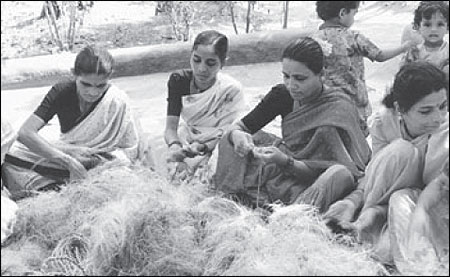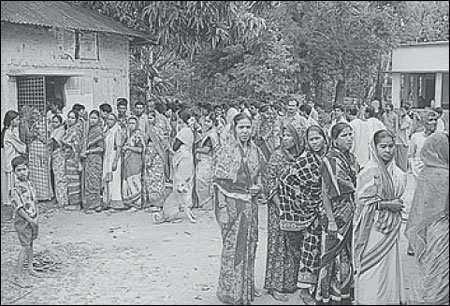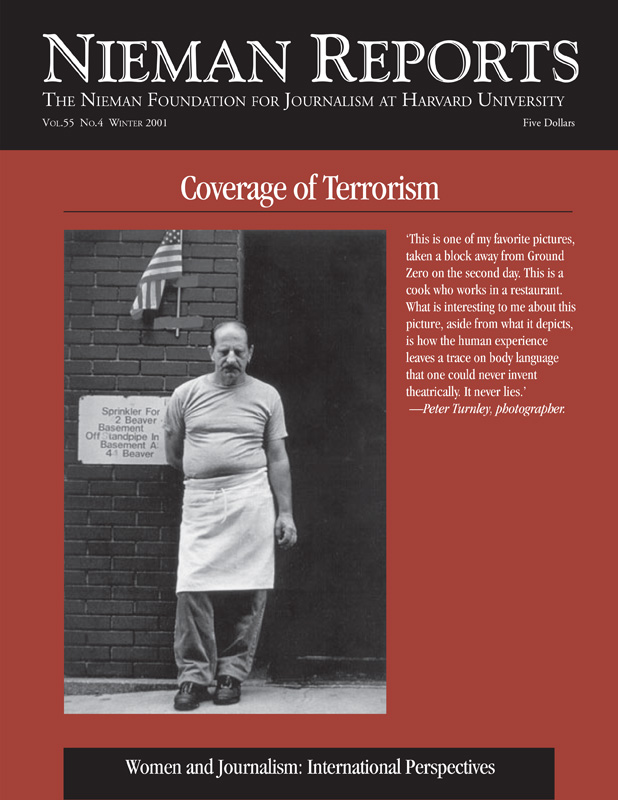
Women engaged in processing coir fiber (fiber obtained from the husk of a coconut). Photo courtesy of The Hindu, India.
In New Delhi, India, is the headquarters of Women’s Feature Service, an international news organization directed and staffed by women who produce articles reported from 40 countries for newspapers, magazines and Web sites. By gathering and providing access to these stories about women’s lives, Women’s Feature Service (WFS) seeks to create “space” for women’s voices and experiences in mainstream media, where such topics don’t usually receive this same kind of attention. WFS produces and markets women-centric articles. It also lobbies decision-makers in newspapers and magazines about such coverage and trains journalists to be able to recognize stories about women’s concerns, to use gender-correct language, and to ask the right questions of appropriate sources.
WFS exists because of the felt need for a gender balance in news coverage and because of dissatisfaction about the ways in which news organizations—in India and elsewhere—treat news coverage about women. Often, the media either ignore important stories altogether, relegate reporting to obscure places in the newspaper, or sensationalize incidents without examining the underlying context or causes. The media tend to focus on women only when it comes to “women’s issues,” forgetting that women also have an equal stake in so-called “male concerns” such as the budget, economy, globalization, agriculture and conflict resolution.
Our experience shows us that newspaper and magazine space for articles on gender-focused subjects is shrinking as commercial pressures increase and owners focus on the balance sheet. We’ve analyzed which of our stories sold well between January and September 2001; those that did include articles on women’s health, women in conflict (including stories about fundamentalism, domestic violence, and human rights), education, religion, political empowerment and travel. WFS’s efforts to speak with senior journalists (both men and women) in newspapers have resulted in serious articles being published by national dailies, state-level newspapers, magazines and some leading Indian-language publications. We’ve also learned that the ways in which we package our stories, and their relevance to current news, matter. But constant effort with marketing these stories is required.
Certain news stories rarely do well. When the subject is domestic violence, rape, dowry deaths, laws on inheritance, divorce and maintenance, sexual harassment, sexual abuse, lack of access to education and health services, police cruelty, and reproductive rights, it is only sensational “bad news” stories that generate interest. Despite the presence of women journalists on the crime beat, incidents of rape and dowry deaths (shockingly regular occurrences in the Indian subcontinent) are usually reported in a routine manner with the police being the sole source of information. Deadline pressure is one reason, but the other is that editors rarely insist that reporters get more information from other sources. Nor is there often any follow-up to an incident. When it comes to issues that impact most directly on women, news that should cause concern and lead to analytical articles that examine a particular issue in depth is often dismissed in a couple of paragraphs on an inside page.
The responsibility of the media to educate, inform and stimulate debate seems often to be forgotten. Moreover, coverage of women’s issues tends to be event-based, not sustained. For instance, little serious writing has been done on proposed laws on domestic violence and sexual harassment in the workplace even though non-governmental organizations (NGO’s) and India’s National Commission for Women have been working on them. The interface between NGO’s and media needs improvement. These are the kinds of stories that we can and do pursue through the Women’s Feature Service.
The other drawback is that there are only a few women writers—and fewer men—who can give a fresh perspective or insights into issues that concern women. Many women journalists have been conditioned (both socially and through the competitiveness of this profession) to adopt masculine attitudes and values. For instance, for a month after the United States declared its EDITOR'S NOTE
More information about the activities and history of WFS can be found at www.wfsnews.org“war on terror” and began bombing Afghanistan, none of the leading newspapers in India wrote on its editorial page about the women in this conflict. At the same time, a leading women’s activist wrote for WFS a thought-provoking piece that argued that the terms of both war and peace were masculine and coercive and that these terms had an impact on women. The article was published on the editorial page of India’s largest newspaper, The Times of India, and subsequently by other publications.
In India, there is a glass ceiling that women journalists have yet to break: Not a single mainline newspaper in India has a woman chief editor. One reason, of course, is that women joined the profession late—the first batch of women entered the profession in the 1960’s—and took to covering politics even later. But it must be pointed out that there are male chief editors who are much younger than many senior women journalists are. Though women journalists have proved as competent, if not more, than men, they still lag behind in the power game. Two women who are at the top—Shobhana Bhartia (managing editor of The Hindustan Times) and Malini Parthasarathy (executive editor of The Hindu)—both belong to the families that own the newspapers. They’ve had to work hard to prove themselves and overcome some amount of intra-office opposition, but the fact remains they would not have risen this far but for their family connections. Interestingly, both do not have brothers, giving rise to the question: Would they have been given these opportunities had there been male siblings?
At The Hindustan Times and The Hindu, the presence of a woman editor has not made much difference in terms of news coverage and treatment. Nor is there any special concern for women journalists (flextime, provision of child care). In fact, when The Hindustan Times had a case of sexual harassment some time ago, the young woman sub-editor was asked by the female managing editor to drop the case she had filed in the court. (The sub-editor went to court after she received no response to her complaint from the management.) The senior male colleague against whom she had filed the case was removed from his position—and promoted! Finally, working conditions in the paper became so hostile that the sub-editor left. She now works as a freelancer.
In 1994, women journalists based in Delhi formed a body called Indian Women’s Press Corps (IWPC). The IWPC seeks to encourage women journalists, promote debate about women’s issues, and provide a forum for networking with fellow professionals, politicians, bureaucrats and academics. While many of these aims are being realized, problems like sexual harassment or discriminatory treatment have not been adequately addressed. One reason is that most members are also employed by publishing houses and wish to avoid unpleasantness—or worse, coercion—from employers.
Women journalists in India have made a lot of progress but still have a long road ahead to gain equality with their male colleagues and influence the manner in which news and issues are handled.

Villagers in West Bengal line up before panchayat (village council) polls. Photo courtesy of The Hindu, India.
Angana Parekh is a senior journalist who has worked for 18 years with two of India’s leading newspapers, the Indian Express and The Hindu. She is now director of Women’s Feature Service, treasurer of the Indian Women’s Press Corps, and serves on the executive committee of WomenAction, an international network of women’s organizations.



